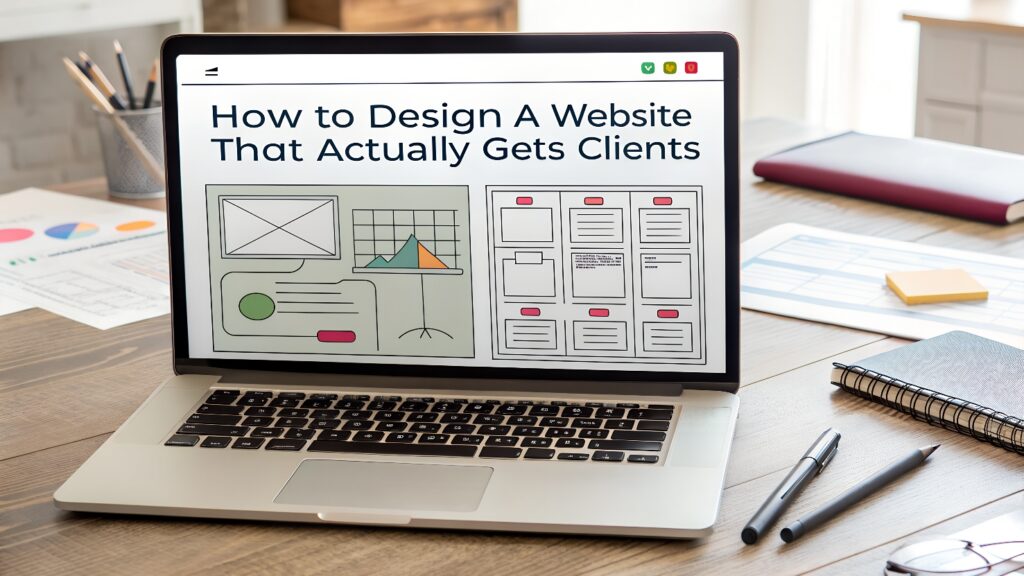Turn Visitors into Buyers with Strategic Website Design
In 2025, your website isn’t just a digital business card — it’s a full-time salesperson. But here’s the truth: most websites don’t actually work. They look nice, sure. But they don’t convert visitors into leads or paying clients.
If you want your website to consistently bring in new business, you need more than just aesthetics — you need strategy. Whether you’re building from scratch or hiring someone for wordpress website development, this guide will walk you through everything you need to know.
Let’s dive into the key ingredients that make websites actually perform.
1. Start With a Clear Goal for Your Website
Before you even pick a template or choose a color palette, ask yourself: What do I want this website to do?
Is your goal to collect emails? Book consultations? Sell products? Every decision — from layout to copy — should support that goal.
Pro tip: Keep one main call to action on every page. Clarity leads to conversions.
2. Know Your Audience (Better Than They Know Themselves)
Effective design starts with understanding who you’re designing for. What are your potential clients struggling with? What questions do they ask before hiring someone like you?
Use that knowledge to craft your content and structure your pages. When people feel like your site “gets them,” they’re more likely to trust you and take action.
3. Use a Clean, Mobile-Friendly Layout
Over 60% of web traffic now comes from mobile devices. If your site looks great on desktop but breaks on phones, you’re losing clients.
Choose responsive templates or frameworks (especially when working on wordpress website development) that adapt seamlessly across devices. Don’t clutter your pages — whitespace is your friend.
4. Speed Matters: Prioritize Website Speed Optimization
Visitors won’t wait more than 2-3 seconds for your site to load — they’ll bounce. That’s why website speed optimization is not optional anymore; it’s mission-critical.
You can boost speed by:
- Compressing images
- Minimizing plugins
- Using caching tools
- Choosing a fast, reliable hosting provider
Google also factors speed into search rankings — so it’s a win for both users and SEO.
5. Craft Compelling Headlines and Subheadings
Your homepage headline is your hook. It should clearly state what you offer and who it’s for — no jargon or fluff.
Example: “High-Impact Digital Marketing for Local Businesses” is better than “Welcome to Our Website.”
Break up your text with subheadings to make scanning easy. Most visitors skim first — if nothing grabs them, they leave.
6. Design With Trust in Mind
People won’t hire you if they don’t trust you. Your site should build credibility through:
- Testimonials
- Case studies
- Certifications or badges
- Client logos (if available)
Even a simple “As seen in” bar or Google Reviews widget adds legitimacy.
If you’re offering custom wordpress website development, showing examples and client results can be even more persuasive.
7. Make Your Contact Info Impossible to Miss
This sounds obvious, but you’d be surprised how many websites hide their phone number or contact form. If your goal is to get leads, don’t make people dig.
Place your contact details in multiple places: header, footer, and a dedicated “Contact” page. Better yet, include a short lead form right on the homepage.
8. Nail Your Call to Action (CTA)
A strong CTA tells visitors exactly what to do next — and why. Avoid vague buttons like “Learn More.” Instead, use action-driven language like:
- “Book Your Free Strategy Call”
- “Get a Custom Quote”
- “Download Our Pricing Guide”
Each page should have one clear CTA aligned with your business goal.
9. Use Real, High-Quality Images (Skip the Stock)
Authentic visuals help visitors connect with your brand. Whenever possible, use real photos of your team, office, products, or client results.
If you’re just starting out, invest in a mini brand photoshoot. It’s a small cost that pays off big in credibility.
Avoid overly generic stock photos — they make your site feel impersonal.
10. Use WordPress for Flexibility and Scalability
For most businesses, wordpress website development is the best long-term platform. It’s SEO-friendly, easy to update, and endlessly customizable.
Whether you need a blog, portfolio, eCommerce shop, or booking system — WordPress has plugins for almost everything.
If you need something highly tailored, consider custom wordpress website development. It gives you control over functionality, design, and performance without the bloat of prebuilt themes.
11. Optimize Every Page for SEO (Search Engine Optimization)
Getting clients from Google is free traffic — and it starts with on-page SEO. Make sure to:
- Use relevant keywords in headings and meta descriptions
- Structure your content with H1, H2, and H3 tags
- Add internal links to related pages
- Write alt text for all images
Combine this with website speed optimization and you’re off to a strong SEO start.
12. Keep Testing and Improving
Even once your site is live, your work isn’t done. Use tools like Google Analytics, Hotjar, or Microsoft Clarity to track how users interact with your site.
A/B test different CTAs, layouts, and copy. Small tweaks — like changing a button color or rewriting a headline — can double your conversions.
Final Thoughts
You don’t need a fancy design degree to create a client-winning website. You just need clarity, strategy, and the right tools.
Whether you’re going the DIY route or hiring someone for custom wordpress website development, follow the steps above and you’ll be way ahead of most small business sites out there.
Want help building a site that gets clients while you sleep? [Contact us here] — we specialize in high-converting, SEO-optimized web design.


